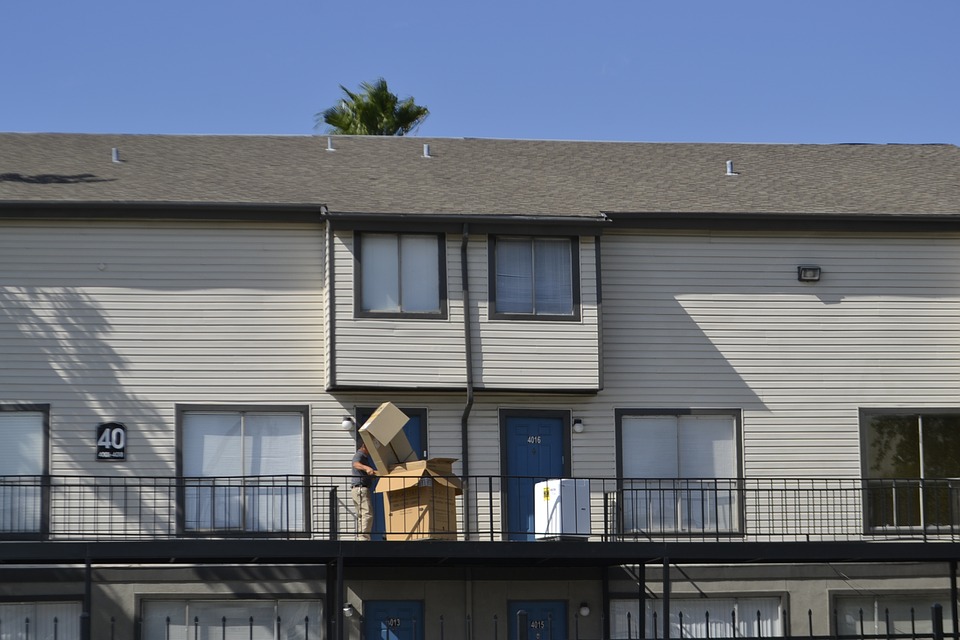
Moving can be a stressful experience. There is so much to pack and plan and declutter, not to mention any big adjustments a new city or neighborhood can bring. The stress intensifies when you’re moving to a smaller home or apartment. Downsizing is no easy task, especially if you’ve been living in a family home for years or are moving to a city where a larger apartment is out of your price range or almost impossible to find.
However, beginning anew in a smaller space need not be a daunting ordeal. With some thoughtful planning, it can be a positive change that makes life better. Below are the top 7 tips provided by Market Apartments for downsizing your home or apartment.
1 – START EARLY AND PLAN WELL
One of the biggest challenges facing those moving to a smaller place is the amount of time you have to actually go through your things and make decisions about what to do with them and what your new place will require. If you know you’ll be downsizing in the near future, start to plan right away. Plan for new or different expenses, as you may be responsible for different utilities. Decide when you need to have gone through your stuff and when the actual move will take place.
Start the decluttering and packing process as soon as possible. This gives you time to decide what actually matters to you, what you will actually need, and what you may need to donate, sell, gift, trash, or store. The process isn’t instantaneous; the more time you allocate, the smoother it will go.
- The average cost of downsizing can range from $2,000 to $5,000, depending on various factors like moving services and storage units.
- The U.S. self-storage industry generated approximately $39.5 billion in annual revenue as of 2020, indicating a high demand for storage during downsizing.
- The average size of a new single-family home in the U.S. has decreased by about 79 square feet since 2015.
- About 12% of Americans move annually, with downsizing being a significant reason.
- The cost of living can decrease by up to 30% when downsizing, depending on the location and lifestyle changes.
2 – EVALUATE YOUR VALUES
Jumping into decluttering your things without really considering what kind of life you want to build in your new home can lead to a lot of frustration. You may hold onto things that you haven’t needed in years or won’t need in the future. You’ll move things that don’t need to be moved. Figure out what items and hobbies you really value. Create an outline or vision board of the kind of lifestyle you want to have so you can keep that in mind as you sort through your life for the move. Ask yourself, “will this fit in with the life I want?” just as often as you consider whether you have the space for the item.
3 – TAKE INVENTORY OF WHAT YOU HAVE AND BE REALISTIC ABOUT WHAT YOU CAN TAKE WITH YOU
We so often lose track of what we have, lose things in junk drawers, or forget about old clothes in the closet. Create a detailed list of all your belongings, and be as accurate and honest with yourself as you can. Knowing what you have will help you be realistic about what can come with you to your new home.
This avoids a lot of surprises down the line as you run out of room in the moving truck or at your new house, or even get stuck with things you thought you got rid of because you weren’t really aware of what you had. Be realistic about your new space and what you will actually need, not just what would be nice to have.
- Consider using a digital home inventory app to keep track of items, especially valuables.
- Look into “tiny home” communities as an alternative downsizing option.
- Research local recycling programs for responsible disposal of electronics and hazardous materials.
- Investigate local estate sale companies if you have a large number of items to sell.
- Use floor plan software to visualize your new space and better decide what to keep.
CONSIDER THE FOLLOWING:
- Plan for things you may have to swap or get smaller versions of like couches, beds, or dining tables.
- Consider the available amenities. For example, if your new place has a gym, you may not need to take your treadmill with you.
- Consider your new neighborhood. Will you still have the same hobbies or take up new ones? Is it walkable? Are there things you will need to get to live there happily?
- Don’t forget about kitchen space when thinking of your small appliances or storage space when considering things like clothes, craft supplies, or outdoor gear.
- Be smart about containers to keep things organized as you declutter and move and be realistic if some of those will need to go into storage. Seasonal items like winter tires, snowboards, hiking gear, or kiddie pools may not be something you feel you need to keep at home. Decide what to do with them.

4 – DECLUTTER
Decluttering is going to be the biggest process of downsizing and it can be a challenge, especially if you’ve raised children in your home or have never had to declutter in a big way before. There are several strategies to decluttering that you can find online or in books, but the biggest tips we’ve found are the following:
- Get rid of duplicates and things you haven’t used in ages. This is an easy place to start because there is little to no chance of regret.
- Start in areas with little emotional attachment or smaller areas like the bathroom. Don’t get overwhelmed at the beginning.
- Save big rooms/projects for last, especially where there are more sentimental items. Sentimental items are difficult to go through, whether or not you decide to declutter them. Wait until you’ve had some practice decluttering and have a good idea of what you actually need and want.
- According to a study, 67% of people said they could eliminate 20% of their possessions without any impact.
- The average American home contains 300,000 items, from paperclips to ironing boards.
- About 54% of Americans are overwhelmed by their clutter but don’t know what to do with it.
- One in seven Americans has a room in their home they cannot use because it is filled with things they rarely use.
- A UCLA study found that the more stuff in a woman’s house, the higher her level of stress hormones.
5 – WHAT TO DO ABOUT MAYBES
If you start early enough and have months to plan, you could put together a box of maybes that you will revisit in the few weeks before the move to make a final decision. If you haven’t thought about it or touched it, let it go. With less time, it’s important to stick to yes or no. You may have to be very strict with yourself to get through, but if you don’t have room for it, you have to let it go.
It’s a challenge when there is something you think you might need in the future or fear you’ll regret getting rid of it. If you have the money for a storage unit, you could put your maybe items there and see if you reach for any of those items within a specified time (ex. 6 months), and declutter those you haven’t needed. But often, a storage unit is an added luxury or you risk forgetting about those items entirely. Take inventory of what you have, make sure to revisit any items left undecided, and stick to a “yes or no” process as much as possible.
6 – DEAL WITH IT EMOTIONALLY
Be prepared for a lot of emotions to come up during the process. Nostalgia can be a strong emotion and you will likely encounter a lot of sentimental items during the process. If you’re struggling to get rid of gifts or are downsizing collections, consider photographing items you can’t take with you. This way, you can remember who gave it to you without the added burden of taking the item itself.
For keepsakes, you could make a keepsake box and decide that if it doesn’t fit in the box, it doesn’t come to the new house. If those methods don’t work, just remember the values you put together at the beginning and stick to those when making your decision.
- Use the “One Year Rule” – if you haven’t used it in a year, you probably don’t need it.
- Consider a “packing party” where friends help you decide what to keep and what to discard.
- Look into multi-functional furniture that can save space in your new home.
- Use vertical space effectively with wall-mounted storage solutions.
- Consider digitalizing sentimental items like photos and children’s artwork to save physical space.
7 – PASS ON ITEMS RESPONSIBLY
When letting go of items, decide what needs to be done with them and pass those items on responsibly. Consider what needs to be donated, recycled, thrown away, or sold, and don’t be afraid to sell things yourself. Don’t pawn items off onto family or friends. It can be difficult to let go, but don’t burden them with things you are afraid to let go of unless you know it is something they will actually use and love. Be smart about what can be reused or recycled, and contact local recycling and donation centers so that your things are appropriately saved or disposed of.
If you have things that still belong to your children, feel free to consult with them. Ask them if there is anything they would like, but give them a timeline because you have one too. You may not be able to continue to hold onto things for them in the move. It’s a challenge with so many memories tied to items, but photos or notes in a journal can bring back those memories just as well.
Uncommon Downsizing Hacks
Downsizing often carries a stigma of being a strenuous, emotionally charged ordeal. What if we flip the script and turn it into an exhilarating adventure? Let’s dive into unconventional hacks that elevate downsizing from a chore to an art form. These aren’t typical tips; they’re inventive strategies rooted in psychology, tech-savviness, and a sprinkle of creativity.
- Virtual Reality Space Planning: Before the boxes come out, don a VR headset and pre-arrange your furniture in your new home. It’s a practical way to see what fits and what needs to go, offering a realistic blueprint for decision-making.
- Reverse Advent Calendar Technique: Shift from adding to subtracting. Remove one item from your space daily for a month, put it in a box, and then donate it. It turns downsizing into a playful experience while reducing emotional attachment to belongings.
- Capsule Wardrobe Challenge: Condense your attire to essential, versatile pieces that pair well together. It not only declutters your wardrobe but also streamlines your daily dressing ritual.
- Digital Keepsake Vault: Scan or 3D-image photos, letters, and sentimental objects. Store them in a secure digital cloud space, retaining their emotional essence without physical bulk.
- Utility vs. Joy Matrix: Craft a 2×2 grid with axes for utility and joy. Classify your items in one of four quadrants to objectively gauge their true value in your life.
- Experience-Based Exchanges: Swap items for enriching experiences rather than selling them. Platforms exist that enable goods-for-experiences trades, turning the act of letting go into a fulfilling exchange.
- One In, Two Out Rule: Each new acquisition in your newly organized space must accompany the departure of two existing items. It sustains the clutter-free environment you’ve achieved.
- Decluttering Gamification: Employ apps that gamify the act of decluttering, replete with rewards and milestones. It adds a layer of engagement, taking the drudgery out of the process.
- Life Audit Exercise: Utilize this transitional phase to reassess your life’s aims. Sync your downsizing strategies with your broader life goals, making it a purposeful life move rather than a begrudging necessity.
- Future Self Visualization: Visualize your future life in a spacious, organized setting. Harness the emotional drive this generates to power your downsizing initiatives.
By employing these ingenious downsizing hacks, you’re not just minimizing stuff, you’re elevating your lifestyle. Each tactic blends pragmatic utility with emotional savvy, ensuring your downsizing journey is as efficient as it is enriching.
Did You Know?
- The Psychology of Letting Go: While downsizing, you’re not just parting with material items but also emotional attachments. Studies have shown that taking photos of sentimental items before donating or selling them can ease the emotional toll.
- Tax Benefits: If you’re 65 or older and have lived in your home for at least two of the last five years, you could exclude up to $250,000 of gain from your income, or up to $500,000 of gain if you’re married and file a joint return. This can be a significant financial relief.
- Virtual Staging: Technology has made it easier to visualize a smaller space before moving. Virtual staging software can help you decide where each piece of furniture will go, reducing the stress of the move.
- The 20/20 Rule: The minimalism movement suggests the 20/20 rule. If you can replace an item in 20 minutes for less than 20 dollars, it might not be worth keeping. This rule can be a lifesaver when you’re on the fence about certain items.
Hidden Challenges in Downsizing Your Home or Apartment
The Emotional Toll of Letting Go
Downsizing often involves parting with items that have sentimental value. This emotional toll can be overwhelming and can lead to decision paralysis.
Solution: Create a digital memory bank. Photograph sentimental items and write a short note about their significance. This approach allows you to hold onto cherished memories without amassing physical clutter.
The Cost of Storage Units
People often resort to storage units for items they can’t part with but don’t have space for. However, the cost can add up.
Solution: Opt for a temporary storage solution. Set a time limit and evaluate the necessity of stored items periodically to avoid indefinite costs.
Overestimating New Space
People frequently overestimate the storage capacity of their new, smaller homes, leading to last-minute chaos.
Solution: Use a tape measure and layout software to place your items in the new space. This will give you a realistic idea of what fits.
Underestimating Time for Sale or Donation
Selling or donating items can take longer than expected, causing delays in the moving schedule.
Solution: Start the process early and set deadlines for each item. If an item doesn’t sell or get donated by the deadline, consider alternative options.
Legal Restrictions on Item Disposal
Certain items like electronics and hazardous materials have legal restrictions on how they can be disposed of.
Solution: Research local laws and facilities that can properly dispose of or recycle these items. Plan this well in advance to avoid legal complications.
Unique Insights and Practical Tips
- Virtual Yard Sale: Utilize social media platforms to quickly sell items you don’t need. It’s faster and reaches a wider audience.
- Digital Document Storage: Scan important papers and store them digitally to save physical space.
- Community Support: Engage with online communities focused on minimalistic living for tips and emotional support.
- Local Services: Utilize local services that pick up items for donation. Some even provide tax deduction receipts.
We all know moving and especially downsizing can be overwhelming and difficult, but it doesn’t have to be. Follow these simple tips, plan ahead, and be realistic about what kind of lifestyle you will have after the move, and things will get easier. There’s always enough space for what really matters to you.
Storage Units In Your City
Weirton, WV Storage Units
Storage Facilities in Alamogordo, HM
Boston, MA Self Storage
Storage Deals in Tuscaloosa, AL
St Cloud, MN Storage Prices





Leave a Comment